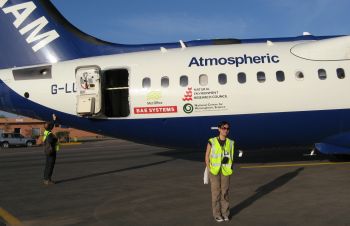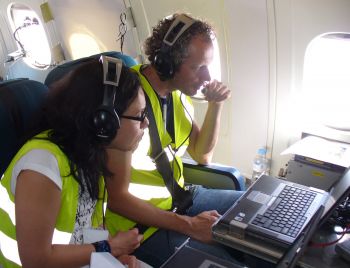Sussex scientists measure the Saharan weather
Posted on behalf of: Geography
Last updated: Friday, 15 February 2013

Dr Carolina Cavazos-Guerra from the Geography department by one of two planes used to fly instruments across the Sahara desert to get an idea of the structure of the atmosphere.

Sussex geographers Dr Carolina Cavazos-Guerra (left) and Professor Martin Todd (right) fly over the central Sahara to collect scientific data.
University of Sussex geographers have been involved in a short film about an academic project to observe one of the most extreme climates on Earth.
The film covers scientific observations of the cloud and dust layers in the central Saharan desert in the summers of 2011 and 2012.
During the summer months, a large, low-pressure system caused by intense solar heating develops over a huge, largely uninhabited expanse of northern Mali, southern Algeria and eastern Mauritania.
The 17-minute film, Into the Cauldron: A metereological adventure, tells the story of a group of specialists who set up an array of special instruments - both on the ground and in the air - to monitor the winds, temperatures and dust in this empty, fiercely hot and inhospitable region.
They also used two aeroplanes to fly instruments across the desert to get an idea of the structure of the atmosphere and how it changes through the day. More than 200 hours of science flights, many at low level (150 feet above the surface) were conducted.
The academics are all part of the Fennec project consortium, in which the University of Sussex is a partner with the Met Office and the Universities of Leeds, Oxford and Reading. The project is funded by the Natural Environment Research Council (NERC).
Professor Martin Todd, Professor of Climate Change at Sussex, says: “Although the central Sahara is extremely remote, it turns out to be vitally important to the world's weather and climate.
“Our measurements of the atmosphere and the processes that make dust and extreme weather in the Sahara will now help us to improve the models that we use to predict weather and climate in the region.”
The film about the project, which was co-ordinated and scripted by Dr Carolina Cavazos-Guerra in the Sussex Geography department, has been submitted for screening at the next meeting of the European Geosciences Union Assembly in April.

